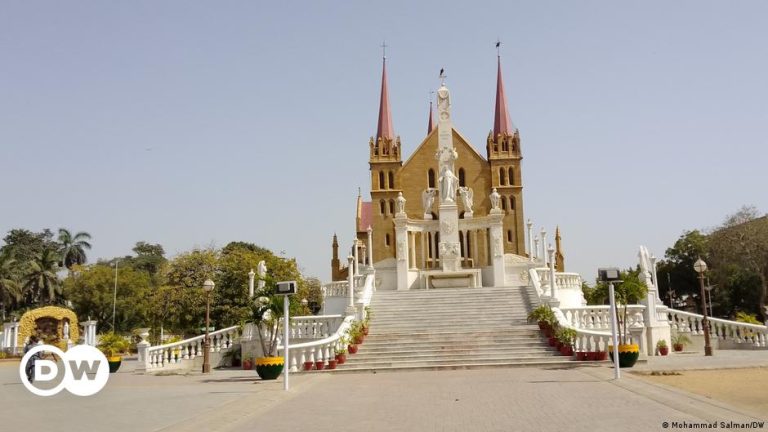Portugal conquered Goa, the seaside state on the west coast of India, in 1510, after which a significant portion of its population converted to Christianity – the majority of whom became Goans. Catholics.
In the first half of the 19th century, a small number of Christians from Goa settled in the port city of Karachi, where they established businesses and gradually increased their numbers.
In 1886, the Goa-Portuguese Association was established, after which the community made valuable contributions to the urban landscape and socio-cultural life of Karachi by establishing educational institutions and constructing breathtaking buildings.
One of them is the Goa-Portuguese Hall, or Goan Gymkhana, designed by the famous Jewish architect Moses Somake and built in the early 20th century.
Even after the partition of India in 1947, when British India was divided into two countries, India And Pakistan – things haven’t changed much for the Goans of Karachi.
But from the 1980s, their numbers began to decline.
Greener Pastures
“(The) Portuguese conquest (of Goa) resulted in the conversion of the locals to Christianity, much of it being forced conversion,” Freddy Nazareth, a former advertising creative director, told DW.
“My grandfather was born in Karachi. My mother was a true Goan. My father was from Mangalore, India. He belonged to a family that migrated from Goa to Mangalore.”
Nazareth explained that a large part of Karachi’s Goan population left for economic reasons.
“The first wave that left the city for the UK were Anglo-Indians, as well as many Goans. They later moved to Montreal, Canada,” he told DW.
Architect and urban planner Arif Hasan had a slightly different view on the departure of Goans from the megacity.
“Goans first came to Karachi as teachers in Catholic institutions when the British started trading and establishing their businesses in Karachi in the 1850s,” explained Hassan, adding that many Others arrived in the 1870s.
“Their schools and churches (St. Patrick’s Cathedral, Goan Union Hall and St. Joseph’s School, etc.) were built between the 1850s and the turn of the century,” Hassan explained.
Goan Christians had no problem organizing festivals in their neighborhoods in and around Saddar region even after the partition of India.
But in the late 1970s, people began to object to the clothing worn by many Christian women in Goa.
“It was during the Pakistan National Alliance (religious) movement in the late 1970s that objections were raised against the dresses women wore, such as skirts and blouses, that they started to give up,” Hassan said. “I think they started leaving town in the ’80s and ’90s.”
In the late 1970s, several Islamic parties rallied against the government of Zulfikar Ali Bhutto, which was later overthrown by General Zia-ul Haq in a military coup. Haq, who ruled the country until the late 1980s, then launched a campaign to Islamize the country.
Opportunities abroad
“The population has declined because as a minority we have limited employment opportunities,” Christopher Vaz, communications manager at a Karachi-based NGO, told DW. “That’s why a number of families moved to Canada, Australia and the United States.”
Although it is difficult to determine with certainty how many members of the Goan Christian community live in Karachi, Delphine D’Mello, a housewife who teaches English, suggested there were thousands.
His claim is supported by local businessman Menin Rodrigues. In his book “Footprints on the Sands of Time — Historical Memories and Reflections, Goans of Pakistan (1820-2020)”, he writes that “Goans continue to live in Karachi, with less than 10,000 inhabitants, but are relatively quiet” .
Lifestyle change
Nazareth highlighted some of the changes taking place in the Christian community in Goa.
“In the old days, women were seen in dresses,” he said. “But I went there two or three months ago and saw a majority of them wearing shalwar kameez,” he added, referring to the traditional national costume worn in Pakistan.
“Even at a wedding in Goa that I attended recently, there were women in shalwar kameez. They have stopped regularly going to church in dresses because it would invite (unwanted) comments.”
Referring to traditions still in vogue, Vaz said: “A lot of our memories revolve around food. The most common is sorpotel, a meat dish with offal. It is essentially a beef dish. Then there are certain wedding traditions. , for example, the roce ceremony in which we anoint the bride and groom with coconut oil and haldi (turmeric).”
D’Mello pointed out that their lifestyles have changed a lot.
“We used to eat fish curry and rice, but now the younger generation is turning to fast food and going to restaurants,” D’Mello said. “Unlike the old people who were miserly, young people like to spend lavishly.”
Edited by: Keith Walker


